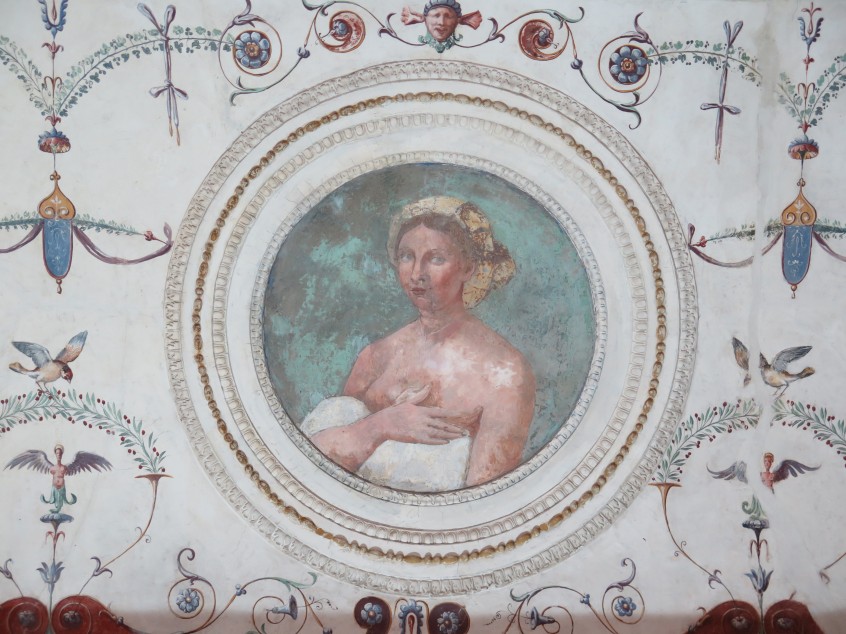[vc_row][vc_column width=”1/1″][text_output]In the three lateral rooms of the villa there are groined ceilings decorated with frescoes. In the middle of the ceilings, in a square, there is the coat of arms of Marcello Lante, who was th bishop of Todi in the beginning of the 17th century, which carries the symbol of the Lante family: three white eagles (in the chancellery of the Vatican Embassy the arms have been destroyed). The vault is decorated with exceptionally skilled grotesque paintings which are symmetrical and stylized, depicting mythological characters as well as floristic and faunistic fantasy figures. The artists of Raphael’s school got their ideas for the grotesque paintings from the “caves” (in Italian ‘grotta’, hence the name of the style), Antique buildings buried under the earth, of which particular significance held the Domus Aurea, the Golden House of Nero. Amongst the paintings in Villa Lante it is easy to recognize also the greyhound, the symbol of Baldassarre Turini and the lion of the Medici family. The ceiling frescoes were severely damaged in the 19th century when the nuns, who owned the villa at that time, covered and scratched out all motifs considered to be indecent. The paintings in the office and in the chancellery only became apparent during the retoration work conducted in 1974-75.
On the ceiling of the Institute’s office there are small rectangular paintings which depict three famous Antique love stories: Amor and Psyche (west and south side), Bacchus and Ariadne (north side) and Orpheus and Eurydike (east side).
The subjects of the frescoes in the chancellery of the Embassy are more difficult to interpret. It seems that some of them are purely decorative with no iconographic meaning at all, while others (west, north and probably east side), can be recognized as scenes from the legend of Jason and the Golden Fleece; next to the portrait of Poliziano, on the north side, can be seen Jason who ploughs with the Vulcan’s oxen. The horseman next to the portrait of Raphael is (probably) Marcus Curtius who, to save his native land, jumped into a chasm that lies in the middle of the Roman Forum.[/text_output][text_output] [/text_output][text_output]The round medallions in the director’s office represent Raphael’s famous female figures. In the northern vault there is a stylized version of the “Veiled Woman” in the Palazzo Pitti in Florence, in the vault towards the salone there is the famous “Fornarina”. In the vault towards the vestibule there is “Gravida”, the original version of this painting is also in Florence, and above the western window there is one of the famous sibyls of the Santa Maria della Pace church. Raphael’s influence can also be seen within the female figures of the Institute’s office, although not as clearly as it can be seen within the director’s office. Particularly interesting is the beautiful portrait of Lucrezia Tornabuoni in the medallion on the northern vault (towards the vestibule), which has been painted after the Domenico Ghirlandaio’s original which is in the Cappella Tornabuoni in the Cathedral of Santa Maria Novella in Florence.
[/text_output][text_output]The round medallions in the director’s office represent Raphael’s famous female figures. In the northern vault there is a stylized version of the “Veiled Woman” in the Palazzo Pitti in Florence, in the vault towards the salone there is the famous “Fornarina”. In the vault towards the vestibule there is “Gravida”, the original version of this painting is also in Florence, and above the western window there is one of the famous sibyls of the Santa Maria della Pace church. Raphael’s influence can also be seen within the female figures of the Institute’s office, although not as clearly as it can be seen within the director’s office. Particularly interesting is the beautiful portrait of Lucrezia Tornabuoni in the medallion on the northern vault (towards the vestibule), which has been painted after the Domenico Ghirlandaio’s original which is in the Cappella Tornabuoni in the Cathedral of Santa Maria Novella in Florence.
The portraits in the chancellery of the Embassy picture famous men of the Florentine tradition: Petrarca (Petrarch), Dante, Poliziano, who was the court poet of the Medici family, and Raphael himself, whose picture has been copied from the so-called “double portrait” (“doppio ritratto”) which is in Louvre.
The frescoes in the lateral rooms illustrate, according to Lilius, Boccaccio’s work “Amorosa Visione”, although the paintings in the villa do not correspond exactly to the poet’s tale. In Boccaccio’s story, a young poet, led by a beautiful maiden, visits an imaginary castle of arts where he sees amiably smiling female figures, portraits of philosophers,poets and mythological scenes.[/text_output][text_output] [/text_output][/vc_column][/vc_row]
[/text_output][/vc_column][/vc_row]

